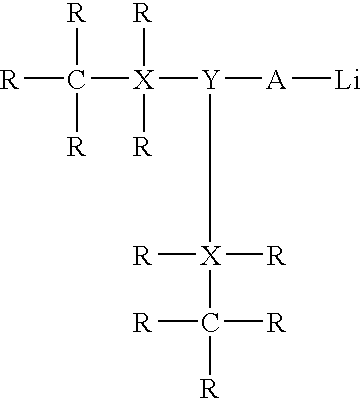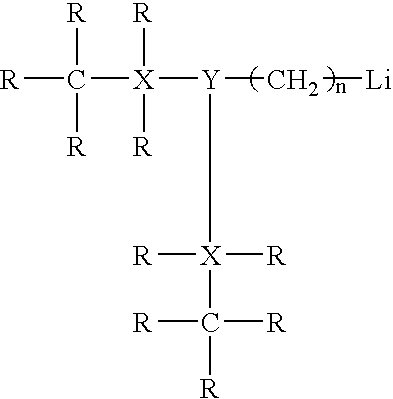Rubbery polymers containing tin coupling agents and rubber compounds including the same
a technology of rubber compounds and tin coupling agents, which is applied in the direction of wheels, tire parts, vehicle components, etc., can solve the problems of lowering hysteresis properties, reducing the rolling resistance and heat build-up of tires during tire operation, and challenging to formulate useful rubber compounds, etc., to achieve desirable wear properties
- Summary
- Abstract
- Description
- Claims
- Application Information
AI Technical Summary
Benefits of technology
Problems solved by technology
Method used
Image
Examples
example 1 (
CONTROL)
[0051]In this control experiment, 2000 g of a hexane premix containing about 20% butadiene monomer(s) was charged to a one gallon stainless steel reactor with an air-driven motor, a nitrogen inlet for providing an inert nitrogen atmosphere, and internal heating / cooling coils for temperature regulation. An anionic-polymerization initiator, i.e., butyllithium, and a modifier, i.e., N,N,N′,N′-tetramethylethylene diamine (“TMEDA”), were added to the premix, respectively, in an amount of 0.5 mmol of initiator per 100 g of the premix and 1.0 mmol of modifier per 100 g of the premix. The molar ratio of butyllithium to TMEDA was 0.5:1. Additionally, 0.3 mmol tin tetrachloride, i.e, SnCl4, was also added to the reactor.
[0052]Polymerization was carried out at 65° C. and the reaction monitored using gas chromatography (“GC”) to detect for the presence of unreacted monomers. After polymerization was completed, ethanol was added to shortstop the polymerization. The polymer cement was the...
example 2
[0053]The procedure described in Example 1 was utilized in this example except that hexachlorodistannoxane, i.e., (Cl3Sn)2O, was used instead of tin tetrachloride to increase the bound rubbery polymer by maximizing the number of carbon-tin bonds between the polybutadiene rubber and the tin coupling agent.
example 3
[0054]The procedure described in Example 1 was utilized in this example except that bis(trichlorostannoxy) butane, i.e., (Cl3Sn)O—(CH2)4—O(Cl3Sn), was used instead of tin tetrachloride to increase the bound rubbery polymer by maximizing the number of carbon-tin bonds.
[0055]The tin coupled rubbery polymers of Examples 1-3 were recovered and characterized using, for example, gel permeation chromatography (GPC). The GPC measurements indicated that the hexachlorodistannoxane functionalized polybutadiene rubber had a number average molecular weight (Mn) of about 100,000 g / mol and the bis(trichlorostannoxy) butane functionalized polybutadiene rubber had an Mn of about 125,000 g / mol whereas the tin tetrachloride functionalized styrene-butadiene rubber had an Mn of about 50,000 g / mol, which suggests that there was an increase in the amount of bound rubbery polymer with the hexachlorodistannoxane and bis(trichlorostannoxy) butane, i.e., that the number of carbon-tin bonds was maximized.
[0056...
PUM
 Login to View More
Login to View More Abstract
Description
Claims
Application Information
 Login to View More
Login to View More - R&D
- Intellectual Property
- Life Sciences
- Materials
- Tech Scout
- Unparalleled Data Quality
- Higher Quality Content
- 60% Fewer Hallucinations
Browse by: Latest US Patents, China's latest patents, Technical Efficacy Thesaurus, Application Domain, Technology Topic, Popular Technical Reports.
© 2025 PatSnap. All rights reserved.Legal|Privacy policy|Modern Slavery Act Transparency Statement|Sitemap|About US| Contact US: help@patsnap.com


